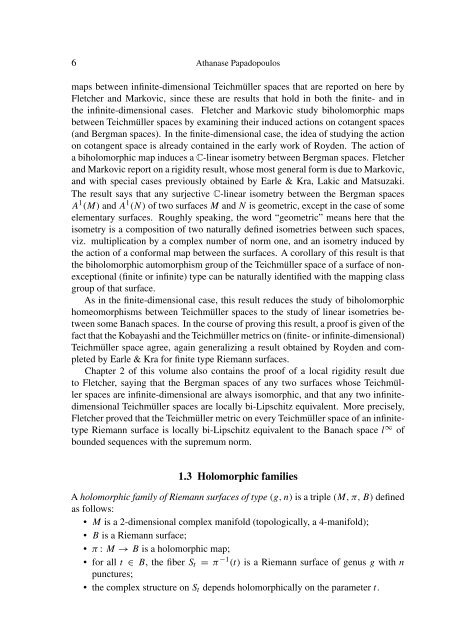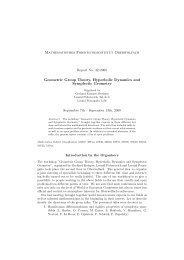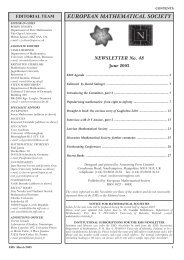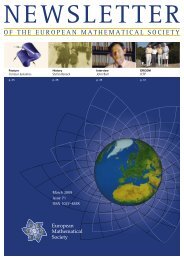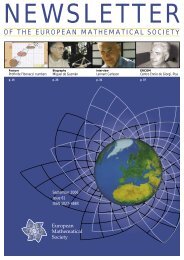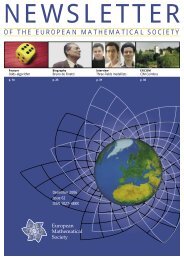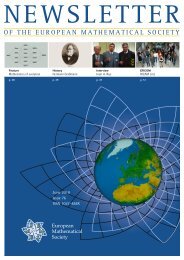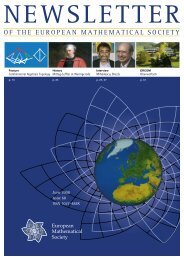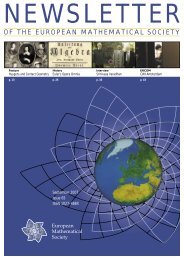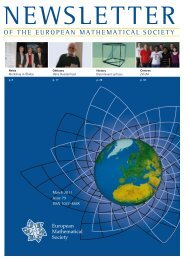Introduction to Teichmüller theory, old and new, II
Introduction to Teichmüller theory, old and new, II
Introduction to Teichmüller theory, old and new, II
Create successful ePaper yourself
Turn your PDF publications into a flip-book with our unique Google optimized e-Paper software.
6 Athanase Papadopoulos<br />
maps between infinite-dimensional <strong>Teichmüller</strong> spaces that are reported on here by<br />
Fletcher <strong>and</strong> Markovic, since these are results that h<strong>old</strong> in both the finite- <strong>and</strong> in<br />
the infinite-dimensional cases. Fletcher <strong>and</strong> Markovic study biholomorphic maps<br />
between <strong>Teichmüller</strong> spaces by examining their induced actions on cotangent spaces<br />
(<strong>and</strong> Bergman spaces). In the finite-dimensional case, the idea of studying the action<br />
on cotangent space is already contained in the early work of Royden. The action of<br />
a biholomorphic map induces a C-linear isometry between Bergman spaces. Fletcher<br />
<strong>and</strong> Markovic report on a rigidity result, whose most general form is due <strong>to</strong> Markovic,<br />
<strong>and</strong> with special cases previously obtained by Earle & Kra, Lakic <strong>and</strong> Matsuzaki.<br />
The result says that any surjective C-linear isometry between the Bergman spaces<br />
A 1 (M) <strong>and</strong> A 1 (N) of two surfaces M <strong>and</strong> N is geometric, except in the case of some<br />
elementary surfaces. Roughly speaking, the word “geometric” means here that the<br />
isometry is a composition of two naturally defined isometries between such spaces,<br />
viz. multiplication by a complex number of norm one, <strong>and</strong> an isometry induced by<br />
the action of a conformal map between the surfaces. A corollary of this result is that<br />
the biholomorphic au<strong>to</strong>morphism group of the <strong>Teichmüller</strong> space of a surface of nonexceptional<br />
(finite or infinite) type can be naturally identified with the mapping class<br />
group of that surface.<br />
As in the finite-dimensional case, this result reduces the study of biholomorphic<br />
homeomorphisms between <strong>Teichmüller</strong> spaces <strong>to</strong> the study of linear isometries between<br />
some Banach spaces. In the course of proving this result, a proof is given of the<br />
fact that the Kobayashi <strong>and</strong> the <strong>Teichmüller</strong> metrics on (finite- or infinite-dimensional)<br />
<strong>Teichmüller</strong> space agree, again generalizing a result obtained by Royden <strong>and</strong> completed<br />
by Earle & Kra for finite type Riemann surfaces.<br />
Chapter 2 of this volume also contains the proof of a local rigidity result due<br />
<strong>to</strong> Fletcher, saying that the Bergman spaces of any two surfaces whose <strong>Teichmüller</strong><br />
spaces are infinite-dimensional are always isomorphic, <strong>and</strong> that any two infinitedimensional<br />
<strong>Teichmüller</strong> spaces are locally bi-Lipschitz equivalent. More precisely,<br />
Fletcher proved that the <strong>Teichmüller</strong> metric on every <strong>Teichmüller</strong> space of an infinitetype<br />
Riemann surface is locally bi-Lipschitz equivalent <strong>to</strong> the Banach space l ∞ of<br />
bounded sequences with the supremum norm.<br />
1.3 Holomorphic families<br />
A holomorphic family of Riemann surfaces of type (g, n) is a triple (M,π,B)defined<br />
as follows:<br />
M is a 2-dimensional complex manif<strong>old</strong> (<strong>to</strong>pologically, a 4-manif<strong>old</strong>);<br />
B is a Riemann surface;<br />
π : M → B is a holomorphic map;<br />
for all t ∈ B, the fiber St = π −1 (t) is a Riemann surface of genus g with n<br />
punctures;<br />
the complex structure on St depends holomorphically on the parameter t.


